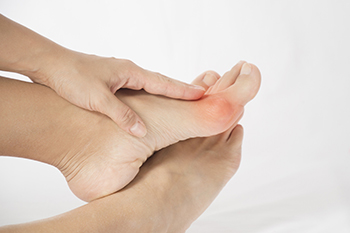
Bunions are a foot condition where the top of the big toe angles toward the second toe, and a bony bump forms at the base of the big toe. They often develop due to genetics, wearing tight or narrow shoes, arthritis, or foot stress. Symptoms include redness, swelling, and soreness surrounding the joint, as well as pain while walking or wearing shoes. The skin over the bunion may become thick and callused, and the toe can become stiff or difficult to move. Bunions can worsen over time, if left untreated, leading to increased discomfort and changes in foot shape. A podiatrist can diagnose a bunion through a physical exam and X-rays to assess its severity. Treatment includes custom orthotics, footwear changes, anti-inflammatory medication, and, in more severe cases, surgery to realign the joint. Early care can prevent further progression and ease discomfort. If you have a painful bunion, it is suggested that you schedule an appointment with a podiatrist for effective relief and treatment solutions.
If you are suffering from bunion pain, contact David K. Morris, DPM of Florida. Our doctor can provide the care you need to keep you pain-free and on your feet.
What Is a Bunion?
Bunions are painful bony bumps that usually develop on the inside of the foot at the joint of the big toe. As the deformity increases over time, it may become painful to walk and wear shoes. Women are more likely to exacerbate existing bunions since they often wear tight, narrow shoes that shift their toes together. Bunion pain can be relieved by wearing wider shoes with enough room for the toes.
Causes
- Genetics – some people inherit feet that are more prone to bunion development
- Inflammatory Conditions - rheumatoid arthritis and polio may cause bunion development
Symptoms
- Redness and inflammation
- Pain and tenderness
- Callus or corns on the bump
- Restricted motion in the big toe
In order to diagnose your bunion, your podiatrist may ask about your medical history, symptoms, and general health. Your doctor might also order an x-ray to take a closer look at your feet. Nonsurgical treatment options include orthotics, padding, icing, changes in footwear, and medication. If nonsurgical treatments don’t alleviate your bunion pain, surgery may be necessary.
If you have any questions, please feel free to contact our office located in Plantation, FL . We offer the newest diagnostic and treatment technologies for all your foot care needs.



